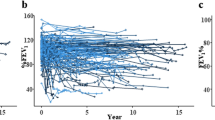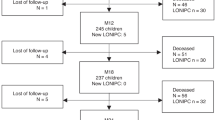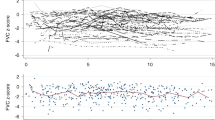Abstract
Abnormal pre-transplant pulmonary function tests (PFTs) are associated with reduced survival after allogeneic HCT. Existing scoring systems consider risk dichotomously, attributing risk only to those with abnormal lung function. In a multicenter cohort of 1717 allo-HCT recipients, we examined the association between pre-transplant PFT measures and need for ICU admission (120d), frequency of mechanical ventilation (120d) and overall survival (5 y). Predictive models were developed and validated using Cox proportional hazards, incorporating age, FEV1 (forced expiratory volume in 1-second) and diffusing capacity (DLCO). In univariate analysis, hazard ratios for each outcome (95% CI) were: mechanical ventilation (FEV1: 0.60 [0.52–0.69], DLCO: 0.69 [0.61–0.77], p < 0.001), ICU admission (FEV1: 0.74 [0.67–0.82], DLCO: 0.79 [0.72–0.86], p < 0.001) and overall survival (FEV1: HR 0.87 [0.81–0.94], DLCO: 0.83 [0.77–0.89], p < 0.001). A multivariable Cox model was developed and compared to the HCT-CI Pulmonary score in a validation cohort. This model was better at predicting need for ICU admission and mechanical ventilation, while both models predicted overall survival (p < 0.001). In conclusion, the risk conferred by pre-transplant pulmonary function should be considered in a continuous rather than dichotomous manner. A more granular prognostication system can better inform risk of critical care utilization in the early post-HCT period.
This is a preview of subscription content, access via your institution
Access options
Subscribe to this journal
Receive 12 print issues and online access
$259.00 per year
only $21.58 per issue
Buy this article
- Purchase on Springer Link
- Instant access to full article PDF
Prices may be subject to local taxes which are calculated during checkout






Similar content being viewed by others
Data availability
The data that support the findings of this study are available from the corresponding author, but restrictions apply given stipulations outlined by the Institutional Review Board approval of this study (Mayo Clinic Rochester, Minnesota, number 13-002869). While unrestricted distribution of patient-level information is restricted, the code used to develop the model is freely available at: https://github.com/hemangyadav/AlloHCT/. We have provided the code used so other centers can utilize our work to examine their own data and derive risk equations specific to their patient population and healthcare practice.
References
Stanojevic S, Kaminsky DA, Miller MR, Thompson B, Aliverti A, Barjaktarevic I, et al. ERS/ATS technical standard on interpretive strategies for routine lung function tests. Eur Respir J. 2022;60. https://doi.org/10.1183/13993003.01499-2021.
Bowerman C, Bhakta NR, Brazzale D, Cooper BR, Cooper J, Gochicoa-Rangel L, et al. A race-neutral approach to the interpretation of lung function measurements. Am J Respir Crit Care Med. 2023;207:768–74. https://doi.org/10.1164/rccm.202205-0963OC.
Quanjer PH, Stanojevic S, Cole TJ, Baur X, Hall GL, Culver BH, et al. Multi-ethnic reference values for spirometry for the 3-95-yr age range: the global lung function 2012 equations. Eur Respir J. 2012;40:1324–43. https://doi.org/10.1183/09031936.00080312.
Swanney MP, Ruppel G, Enright PL, Pedersen OF, Crapo RO, Miller MR, et al. Using the lower limit of normal for the FEV1/FVC ratio reduces the misclassification of airway obstruction. Thorax. 2008;63:1046–51. https://doi.org/10.1136/thx.2008.098483.
Miller MR, Quanjer PH, Swanney MP, Ruppel G, Enright PL. Interpreting lung function data using 80% predicted and fixed thresholds misclassifies more than 20% of patients. Chest. 2011;139:52–59. https://doi.org/10.1378/chest.10-0189.
Afessa B, Abdulai RM, Kremers WK, Hogan WJ, Litzow MR, Peters SG. Risk factors and outcome of pulmonary complications after autologous hematopoietic stem cell transplant. Chest. 2012;141:442–50. https://doi.org/10.1378/chest.10-2889.
Yadav H, Nolan ME, Bohman JK, Cartin-Ceba R, Peters SG, Hogan WJ, et al. Epidemiology of acute respiratory distress syndrome following hematopoietic stem cell transplantation. Crit Care Med. 2016;44:1082–90. https://doi.org/10.1097/CCM.0000000000001617.
Herasevich S, Frank RD, Bo H, Alkhateeb H, Hogan WJ, Gajic O, et al. Pretransplant risk factors can predict development of acute respiratory distress syndrome after hematopoietic stem cell transplantation. Ann Am Thorac Soc. 2021;18:1004–12. https://doi.org/10.1513/AnnalsATS.202004-336OC.
Bellani G, Laffey JG, Pham T, Fan E, Brochard L, Esteban A, et al. Epidemiology, patterns of care, and mortality for patients with acute respiratory distress syndrome in intensive care units in 50 countries. Jama. 2016;315:788–800. https://doi.org/10.1001/jama.2016.0291.
Rios F, Iscar T, Cardinal-Fernandez P. What every intensivist should know about acute respiratory distress syndrome and diffuse alveolar damage. Rev Brasileira de Ter Intensiv. 2017;29:354–63. https://doi.org/10.5935/0103-507x.20170044.
Efrati O, Toren A, Duskin H, Modan-Moses D, Bielorai B, Goldstein G, et al. Pulmonary function studies in children treated by chemoradiotherapy and stem cell transplantation. Pediatr Blood Cancer. 2008;51:684–8. https://doi.org/10.1002/pbc.21722.
Wenger DS, Triplette M, Crothers K, Cheng GS, Hill JA, Milano F, et al. Incidence, risk factors, and outcomes of idiopathic pneumonia syndrome after allogeneic hematopoietic cell transplantation. Biol Blood Marrow Transpl. 2020;26:413–20. https://doi.org/10.1016/j.bbmt.2019.09.034.
Crawford SW, Fisher L. Predictive value of pulmonary function tests before marrow transplantation. Chest. 1992;101:1257–64. https://doi.org/10.1378/chest.101.5.1257.
Ghalie R, Szidon JP, Thompson L, Nawas YN, Dolce A, Kaizer H. Evaluation of pulmonary complications after bone marrow transplantation: the role of pretransplant pulmonary function tests. Bone Marrow Transpl. 1992; 10:359−65.
Ho VT, Weller E, Lee SJ, Alyea EP, Antin JH, Soiffer RJ. Prognostic factors for early severe pulmonary complications after hematopoietic stem cell transplantation. Biol Blood Marrow Transpl. 2001;7:223–9. https://doi.org/10.1053/bbmt.2001.v7.pm11349809.
Suarez EU. Hottest topics in hematopoietic stem cell transplantation: a summary from the 8th International Transplant and Cellular Therapy Course. Clin Hematol Int. 2023;5:89034. https://doi.org/10.46989/001c.89034.
Sorror ML, Maris MB, Storb R, Baron F, Sandmaier BM, Maloney DG, et al. Hematopoietic cell transplantation (HCT)-specific comorbidity index: a new tool for risk assessment before allogeneic HCT. Blood. 2005;106:2912–9. https://doi.org/10.1182/blood-2005-05-2004.
Veeraputhiran M, Yang L, Sundaram V, Arai S, Lowsky R, Miklos D, et al. Validation of the hematopoietic cell transplantation-specific comorbidity index in nonmyeloablative allogeneic stem cell transplantation. Biol Blood Marrow Transpl. 2017;23:1744–8. https://doi.org/10.1016/j.bbmt.2017.06.005.
Raimondi R, Tosetto A, Oneto R, Cavazzina R, Rodeghiero F, Bacigalupo A, et al. Validation of the hematopoietic cell transplantation-specific comorbidity index: a prospective, multicenter GITMO study. Blood. 2012;120:1327–33. https://doi.org/10.1182/blood-2012-03-414573.
Sorror ML, Sandmaier BM, Storer BE, Franke GN, Laport GG, Chauncey TR, et al. Long-term outcomes among older patients following nonmyeloablative conditioning and allogeneic hematopoietic cell transplantation for advanced hematologic malignancies. Jama. 2011;306:1874–83. https://doi.org/10.1001/jama.2011.1558.
Miller MR, Pedersen OF, Lange P, Vestbo J. Improved survival prediction from lung function data in a large population sample. Respir Med. 2009;103:442–8. https://doi.org/10.1016/j.rmed.2008.09.016.
Lange P, Nyboe J, Appleyard M, Jensen G, Schnohr P. Spirometric findings and mortality in never-smokers. J Clin Epidemiol. 1990;43:867–73. https://doi.org/10.1016/0895-4356(90)90070-6.
Chinn S, Gislason T, Aspelund T, Gudnason V. Optimum expression of adult lung function based on all-cause mortality: results from the Reykjavik study. Respir Med. 2007;101:601–9. https://doi.org/10.1016/j.rmed.2006.06.009.
Sheshadri A, Makhnoon S, Alousi AM, Bashoura L, Andrade R, Miller CJ, et al. Home-based spirometry telemonitoring after allogeneic hematopoietic cell transplantation: mixed methods evaluation of acceptability and usability. JMIR Form Res. 2022;6:e29393. https://doi.org/10.2196/29393.
von Elm E, Altman DG, Egger M, Pocock SJ, Gotzsche PC, Vandenbroucke JP. The Strengthening the Reporting of Observational Studies in Epidemiology (STROBE) statement: guidelines for reporting observational studies. Lancet. 2007;370:1453–7. https://doi.org/10.1016/S0140-6736(07)61602-X.
Graham BL, Steenbruggen I, Miller MR, Barjaktarevic IZ, Cooper BG, Hall GL, et al. Standardization of Spirometry 2019 update. an official american thoracic society and european respiratory society technical statement. Am J Respir Crit Care Med. 2019;200:e70–88. https://doi.org/10.1164/rccm.201908-1590ST.
Macintyre N, Crapo RO, Viegi G, Johnson DC, van der Grinten CP, Brusasco V, et al. Standardisation of the single-breath determination of carbon monoxide uptake in the lung. Eur Respir J. 2005;26:720–35. https://doi.org/10.1183/09031936.05.00034905.
Miller MR, Hankinson J, Brusasco V, Burgos F, Casaburi R, Coates A, et al. Standardisation of spirometry. Eur Respir J. 2005;26:319–38. https://doi.org/10.1183/09031936.05.00034805.
Wanger J, Clausen JL, Coates A, Pedersen OF, Brusasco V, Burgos F, et al. Standardisation of the measurement of lung volumes. Eur Respir J. 2005;26:511–22. https://doi.org/10.1183/09031936.05.00035005.
Stanojevic S, Graham BL, Cooper BG, Thompson BR, Carter KW, Francis RW et al. Official ERS technical standards: global lung function initiative reference values for the carbon monoxide transfer factor for Caucasians. Eur Respir J. 2017;50. https://doi.org/10.1183/13993003.00010-2017.
Graham BL, Brusasco V, Burgos F, Cooper BG, Jensen R, Kendrick A et al. 2017 ERS/ATS standards for single-breath carbon monoxide uptake in the lung. Eur Respir J. 2017;49. https://doi.org/10.1183/13993003.00016-2016.
Quanjer PH, Stanojevic S, Cole TJ, Stocks J. Quanjer GLI-2012 regression equation and lookup tables. global lung function initiative. 2012. https://www.ers-education.org/lr/show-details/?idP=138978.
Gray RJ. A class of K-sample tests for comparing the cumulative incidence of a competing risk. Ann Stat. 1988;16:1141–54. https://doi.org/10.1214/aos/1176350951.
Jules-Elysee K, Stover DE, Yahalom J, White DA, Gulati SC. Pulmonary complications in lymphoma patients treated with high-dose therapy autologous bone marrow transplantation. Am Rev Respir Dis. 1992;146:485–91. https://doi.org/10.1164/ajrccm/146.2.485.
Parimon T, Madtes DK, Au DH, Clark JG, Chien JW. Pretransplant lung function, respiratory failure, and mortality after stem cell transplantation. Am J Respir Crit Care Med. 2005;172:384–90. https://doi.org/10.1164/rccm.200502-212OC.
Pedone C, Scarlata S, Scichilone N, Forastiere F, Bellia V, Antonelli-Incalzi R. Alternative ways of expressing FEV1 and mortality in elderly people with and without COPD. Eur Respir J. 2013;41:800–5. https://doi.org/10.1183/09031936.00008812.
Patel H, Hassell A, Cyriacks B, Fisher B, Tonelli W, Davis C. Building a real-time remote patient monitoring patient safety program for COVID-19 patients. Am J Med Qual. 2022;37:342–7. https://doi.org/10.1097/JMQ.0000000000000046.
Astashchanka A, Ryan J, Lin E, Nokes B, Jamieson C, Kligerman S, et al. Pulmonary complications in hematopoietic stem cell transplant Recipients-A clinician primer. J Clin Med. 2021;10. https://doi.org/10.3390/jcm10153227
Chang E, Iukuridze A, Echevarria M, Teh JB, Chanson D, Ky B, et al. Feasibility and acceptability of using a telehealth platform to monitor cardiovascular risk factors in hematopoietic cell transplantation survivors at risk for cardiovascular disease. Biol Blood Marrow Transpl. 2020;26:1233–7. https://doi.org/10.1016/j.bbmt.2020.02.027.
Acknowledgements
This project was supported by Grant Number K23HL151671 (HY) from the National Heart, Lung and Blood Institute of the National Institute of Health. Its contents are solely the responsibility of the authors and do not necessarily represent the official views of the NIH.
Funding
NIH/NHLBI Grant Number K23HL151671 (recipient: Hemang Yadav).
Author information
Authors and Affiliations
Contributions
HY conceived the work leading to the submission, acquired data, interpreted data, analyzed results and drafted the manuscript. SH, ZZ and BW acquired data and revised the manuscript. MHT, WH, AN and OG helped with project design and data interpretation and revised the manuscript. PJS helped with data interpretation and revised the manuscript. All authors have approved the final version of the manuscript and agree to be accountable for all aspects of the work.
Corresponding author
Ethics declarations
Competing interests
The authors declare no competing interests.
Additional information
Publisher’s note Springer Nature remains neutral with regard to jurisdictional claims in published maps and institutional affiliations.
Supplementary information
Rights and permissions
Springer Nature or its licensor (e.g. a society or other partner) holds exclusive rights to this article under a publishing agreement with the author(s) or other rightsholder(s); author self-archiving of the accepted manuscript version of this article is solely governed by the terms of such publishing agreement and applicable law.
About this article
Cite this article
Yadav, H., Herasevich, S., Zhang, Z. et al. Pulmonary function as a continuum of risk: critical care utilization and survival after allogeneic hematopoietic stem cell transplantation - a multicenter cohort study. Bone Marrow Transplant (2024). https://doi.org/10.1038/s41409-024-02265-8
Received:
Revised:
Accepted:
Published:
DOI: https://doi.org/10.1038/s41409-024-02265-8



